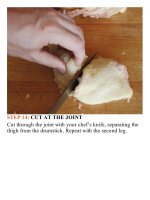The food lab better home cooking through science ( PDFDrive ) 232
Bạn đang xem bản rút gọn của tài liệu. Xem và tải ngay bản đầy đủ của tài liệu tại đây (133.71 KB, 2 trang )
high.Unlessyouenjoywearinghotsoup.
• An immersion blender can give you a
decently smooth result, depending on the power of your
blender. It’s by far the most convenient way to make
soup, and it’s a good choice if you’re fine with a rustic,
kindofchunkytexture.
• A food processor should be your last choice.
Becauseofitswidebaseandrelativelylowspinningrate,
afoodprocessordoesmorechoppingthanpureeing.
Whatever the pureeing method, I like to emulsify my
soup with some fat during this stage—either butter or olive
oil.Thisaddsarichtexturetothesoup.
Some recipes (including many of mine) will tell you to
slowlydrizzleinfatoraddbutteraknobatatimewhilethe
blenderisrunning,whichisasurefirewaytogetyourfatto
emulsifyproperly,buthere’sasecret:solongasyoudon’t
have the world’s worst blender (and somebody out there
does!),there’snorealneedtodrizzleinthefatslowly.The
vortex action of a blender is plenty powerful enough to
emulsifythefatevenifyoujustdumpitallinatonce.
Iftheultimateinsmoothnessisyourgoal,finishoffyour
pureed soup by using the bottom of a ladle to press it
through a chinois or an ultra-fine-mesh strainer. The end
resultsshouldbesmootherthanJohnTravoltastruttingwith
adouble-deckerpizzaslice.
Step7:FinishwithAcidandSeason
Seasoningisthefinalstepjustbeforeplatingandservingin
anyrecipe.Youcanseasonasyougo,butyouneverknow
ifyoursouphastherightlevelofsaltuntilyoutasteitinits
finalform.Nowisthetimetodothat.
Equally important to bring out the best flavor in a recipe
is acid. Because acidic ingredients quickly dull in flavor
whencooked,it’sbesttoaddfreshacidrightattheend,just
before serving. For most vegetable-based dishes, lemon
juice or lime juice is a great option, as their aroma
complements vegetal flavors. Other good options would be
adashofcidervinegar,winevinegar,ormyfavorite,sherry
vinegar. The latter goes particularly well with soups made
withplentyofextra-virginoliveoil.
Step8:GarnishandServe
Your soup is essentially done at this stage, but a little
garnishneverhurtanybody.Herearesomeoptions:
• Flavorful oils, like walnut, pistachio, squash seed, or
argan.
• Chopped fresh herbs or tender alliums, like parsley,
tarragon,chives,orslicedscallions.
•Sautéedvegetables,likemushrooms,leeks,orgarlic.
• Nuts, like almonds, hazelnuts, or pine nuts, toasted in
oliveoilorbutter.
• Simple gremolata-style mixtures, like a blend of parsley,
lemonzest,andgratedgarlic.
•Thinlyslicedchilies.
•Adrizzleofbrownedbutter.
• Dairy products, like sour cream, crème frche, or heavy
cream;plainorflavoredwithspicesorpastes.Usingahint









